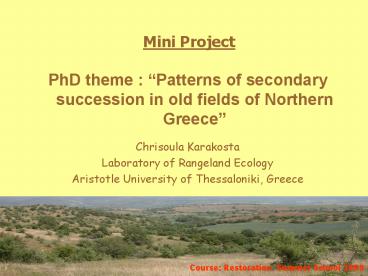afea 1 PowerPoint PPT Presentation
Title: afea 1
1
Mini Project
PhD theme Patterns of secondary succession in
old fields of Northern Greece
Chrisoula Karakosta Laboratory of Rangeland
Ecology Aristotle University of Thessaloniki,
Greece
Course Restoration Summer School 2009
2
Introduction
Research aim To study mechanisms of vegetation
succession on abandoned fields
3
The main questions of the research are
- Which factors control the succession pattern,
- ii) Which development model describes better this
successional pattern and outline, - iii) How do life form and species richness change
along successional gradient, - iv) Which are the effects of land use change on
plant functional traits (PFTs).
4
- Methods Data
- Old fields representing a gradient of land use
abandonment (1950, 1960, 1970, 1980, 1990, 2000,
and 2007) - Vegetation sampling (spring-summer)
- Soil samples (autumn)
- Topographic, geological and climatic data
- Trait data measurements (spring-summer)
5
Methods Data
- species composition (point method)
- species cover (point method)
- biodiversity indices (quadrat)
- aboveground biomass (harvesting)
- -sorted out current years and old
- growth components
Vegetation data
6
Methods Data
- N, P, K, Ca, Mg concentration
- pH, organic matter
- texture
Soil data (depth 2 lever 0-5cm and 5-20cm)
- Altitude
- Aspect
- slope
Topographic data
Geological data
derived from a geological maps
Climatic data
Collected from meteorological station
7
Methods Data TRAIT MEASUREMENTS
Measurements on the dominant species in each old
field
Leaf traits
SLASpecific leaf area LDMCLeaf dry matter
content LNCLeaf nitrogen concentration LPCLeaf
phosphorus concentration LCC-Leaf carbon
concentration
Stem traits StDMCStem dry matter content
8
Pending
- -Laboratory work
- Chemical analysis
- -Data analysis
- Data collection for species traits from
bibliography (life forms, life cycle, Pollination
mode, dispersal mode, Clonality, etc.) - - Statistical analysis
9
Thank you for your attention !!!
PowerShow.com is a leading presentation sharing website. It has millions of presentations already uploaded and available with 1,000s more being uploaded by its users every day. Whatever your area of interest, here you’ll be able to find and view presentations you’ll love and possibly download. And, best of all, it is completely free and easy to use.
You might even have a presentation you’d like to share with others. If so, just upload it to PowerShow.com. We’ll convert it to an HTML5 slideshow that includes all the media types you’ve already added: audio, video, music, pictures, animations and transition effects. Then you can share it with your target audience as well as PowerShow.com’s millions of monthly visitors. And, again, it’s all free.
About the Developers
PowerShow.com is brought to you by CrystalGraphics, the award-winning developer and market-leading publisher of rich-media enhancement products for presentations. Our product offerings include millions of PowerPoint templates, diagrams, animated 3D characters and more.

